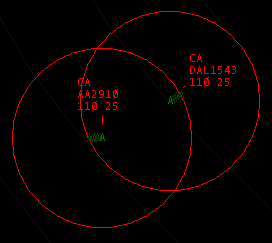|
VRC Documentation
Conflict Alerts
Sometimes, despite your best efforts, two aircraft will get a bit too close and you'll lose minimum separation between them. This is called a conflict. VRC provides a number of options for determining when conflicts are detected and alerts are triggered. See "Configuring VRC" for details on these settings.
VRC allows you to set a minimum for both vertical and lateral separation between aircraft under your control. You can also specify an altitude floor below which conflicts will not be detected. This is useful if you are getting false conflict alerts from aircraft flying in the pattern at an airport within your airspace while working approach.
When a conflict is detected between two aircraft under your control, VRC sounds a looping conflict alert warning and optionally draws separation rings around the aircraft. The radius of these rings is equal to the lateral separation minimum you specify in the General Settings. Depending on the selected radar mode, you may also see a blinking "CA" notification above the datablock. Also, the datablock color will change to the color you have selected for aircraft in conflict. Here's a screenshot of a conflict:

VRC will also add a button to the Button Bar indicating that there is a conflict detected. Here's a screenshot:

To silence the conflict alert sound, click the above button, press CTRL+S or type .silence. The conflict will still be displayed on the scope, but the looping conflict alert sound will stop.
Any conflict in progress will continue to be displayed until the conflict is resolved. VRC calculates the flight path of the two aircraft and cancels the conflict alert if it determines that separation is increasing. As long as the separation remains below minimums and is either remaining constant or decreasing, the conflict alert will continue to be displayed.
Note that aircraft not being tracked by you can still cause a conflict, but you will only see the separation rings and hear the conflict sound if you are tracking one or both of the conflicting aircraft.
[ Print this page ]
|
| © Copyright 2005 Ross Alan Carlson - All Rights Reserved |